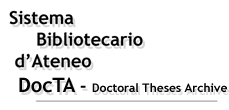|
|
DocTA - Doctoral Theses Archive >
Tesi di dottorato >
SCUOLA DI DOTTORATO IN POLITICA ECONOMICA >
Citazione:
Utilizza queste indicazioni per citare o creare un link a questo documento.
|
Tettamanti, Stefano. "EUROPEAN STRUCTURAL FUNDS OVER THE 2000 - 2006 PERIOD: RECONSTRUCTION OF REGIONAL DISTRIBUTION AND EVALUATION OF THEIR IMPACT OVER REGIONAL CONVERGENCE", Università Cattolica del Sacro Cuore, XXV ciclo, a.a. 2012/13, Milano, [http://hdl.handle.net/10280/3675].
|
| Titolo: | EUROPEAN STRUCTURAL FUNDS OVER THE 2000 - 2006 PERIOD: RECONSTRUCTION OF REGIONAL DISTRIBUTION AND EVALUATION OF THEIR IMPACT OVER REGIONAL CONVERGENCE |
| Autore/i: | TETTAMANTI, STEFANO |
| Tutor: | TIMPANO, FRANCESCO |
| Coordinatore: | CAMPIGLIO, LUIGI PIERFRANCO |
| Lingua: | ENG |
| Abstract in italiano della tesi: | Ampia discussione è in corso riguardo ai Fondi Strutturali Europei, uno strumento creato dall’Unione Europea per ridurre le differenze economiche tra le sue regioni. Durante il CSF 2000-06 essi hanno rappresentato 1/3 del budget comunitario. Nonostante tale sforzo, parte della letteratura trova scarsi effetti e persistenza nei differenziali di PIL che i fondi dovrebbero ridurre.
In questo lavoro si affronterà la questione osservando le regioni dell’EU-15, nel periodo 2000-07. L’effetto dei fondi è stato dapprima stimato con modelli di convergenza assoluta e considerando problemi come l’autocorrelazione spaziale e l’eterogeneità delle regioni. L’attenzione si è quindi diretta alla costruzione di un dataset contenente cifre dettagliate dei fondi pagati annualmente a ciascuna regione, tramite combinazione di informazioni da fonti ufficiali e tramite stime per coprire le cifre per cui tali informazioni erano mancanti. Con questo dataset sono quindi stati stimati modelli che considerassero effetti di spill-over e la possibilità di cluster convergence.
È risultato che i fondi strutturali hanno effetti tutto sommato positivi. L’utilizzo di modelli più complessi e realistici ha però mostrato una debole convergenza, lasciando quindi dubbi sull’effettiva efficacia dei fondi. |
| Abstract in inglese: | A vast discussion is underway regarding European structural funds, an instrument the European Union created in order to reduce the economic differentials among its regions. During the 2000-2006 CSF they represented 1/ 3 of EU budget. Despite these efforts, part of the literature finds small effects and persistence in those differences in GDP which these funds should reduce.
In this work the issue will be addressed by looking at regions within EU-15, in the period 2000-2007. Proof of the positive effect of funds was first searched using models of absolute beta convergence and addressing issues like spatial autocorrelation and heterogeneity between regions. The attention moved then to the task of constructing a dataset which could provide detailed figures on funding paid to each region each year, by combining information available from official sources and through the estimation of those figures for which information was missing. On the base of this dataset new models were estimated, taking into account the spill-over effects and the possibility of cluster convergence.
The result was that structural funds have, overall, a positive impact. Once we move to more complex and realistic models, convergence becomes weaker, casting some doubts on the effectiveness of these funds. |
| Data di discussione: | 29-apr-2014 |
| URI: | http://hdl.handle.net/10280/3675 |
| È visualizzato nelle collezioni: | SCUOLA DI DOTTORATO IN POLITICA ECONOMICA
FACOLTA' DI ECONOMIA
|
File in questo documento:
| File |
Descrizione |
Dimensioni | Formato | Accessibilità |
|---|
| tesiphd_completa_Tettamanti.pdf | Tesi Completa | 4,09 MB | Adobe PDF | non consultabile
|
|
Accesso e utilizzo dei contenuti di DocTA
|



